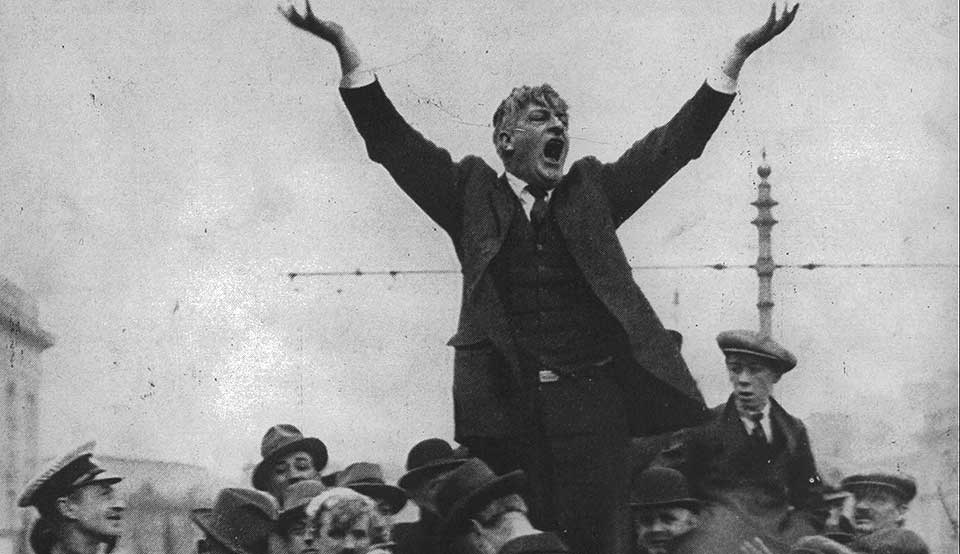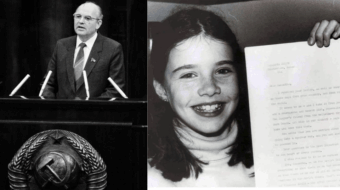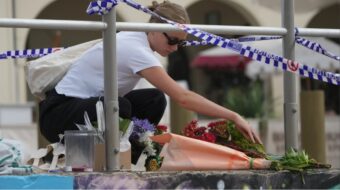
The Dublin lockout of 1913 was one of the greatest industrial disputes in Irish history. The conflict between some 20,000 workers and 300 employers lasted from Aug. 26,1913, to January 18, 1914. Its core demand was the right to organize.
Dublin’s tenements were among the most squalid in Europe. People lived crammed together, infant mortality was enormous, tuberculosis was rampant. Unskilled workers competed daily for poorly paid jobs and were at the mercy of employers.
James Larkin, Liverpool dockworker, was sent to Belfast in 1907 as a trade unionist with the National Union of Dock Labourers (NUDL), where he organized a dock and transport workers’ strike. Considered militant and controversial by the union leadership, Larkin was transferred to Dublin where he set about organizing the unskilled laborers. This led to his suspension from the British NUDL in 1908, who feared an all-out industrial dispute with the powerful Dublin employers.
Larkin left the NUDL and founded the Irish Transport and General Workers Union (ITGWU), which for the first time represented the unskilled as well as skilled workforce. Employers who suspected their workers of wanting to organize could blacklist them, thereby destroying any chance of future employment. The ITGWU spread to other cities in Ireland with growing success in industrial action, and between 1911 and 1913, its membership increased to 10,000.
Alongside Larkin, the Marxist James Connolly played an instrumental role in the rise of an organized labor movement in Ireland, focusing his attention equally on socialist liberation from the British colonial yoke. In 1896, Connolly founded the Marxist-oriented Irish Socialist Republican Party and Ireland’s first regular socialist newspaper, The Workers’ Republic. In 1911, Connolly became organizer of the ITGWU in Belfast. In 1912 he co-founded the Irish Labour Party with Larkin.
When the mass lockout in Dublin threatened, Larkin sent for Connolly, who was in Belfast at the time, to help him organize large meetings of the ITGWU. When the lockout began, Connolly led the dispute along with Larkin. As well as writing articles about the lockout for various workers’ newspapers, he addressed mass gatherings in Dublin. After both were arrested following one such event, Connolly was released due to his hunger strike and later led the strike during Larkin’s three-week imprisonment. He also organized the support campaign for the Dublin workers in Britain.

Among their opponents was William Martin Murphy, big businessman and most prominent representative of the Irish bourgeoisie, who declared: “Either Larkin rules Dublin or we do.” Murphy understood the threat posed by the new trade unionism developed by Larkin and Connolly and did everything in his power to end their influence. In August 1913, Murphy sacked hundreds of workers he suspected of ITGWU membership and gave them an ultimatum between union membership and their jobs. Members of 37 unions refused to sign the document. And so began the lockout in Dublin.
All efforts by British unions to negotiate a settlement were sabotaged by the employers. A police raid on Aug. 31, 1913, left two dead and hundreds injured. It was largely at Connolly’s instigation that the Irish Citizen Army was formed to protect the striking workers and continued to play an important role in 1916.
Connolly and Larkin ultimately appealed unsuccessfully in England for solidarity strikes by the British working class as the only way to bring about a victory for the Irish workers. Without this support from the British workers, Dublin had to admit defeat after five months of heroic struggle. Most of the workers, many on the verge of starvation, returned to their jobs and pledged not to join the ITGWU. Larkin left for the U.S. in 1914 and Connolly was executed in 1916 as one of the leaders of the Easter Rising. Many workers who were irrevocably blacklisted joined the British army and became cannon fodder in the First World War.
The years from 1907 to 1914 are the subject of James Plunkett’s book Strumpet City. The novel traces the life of the working class in Dublin at that time and brings this historical moment vividly and impressively to readers even today.
Strumpet City
Set in this period before Irish independence, the collective hero of Plunkett’s 1969 novel is the Irish working class as it enters a new phase of its class struggle. The bourgeoisie at that time was also directly dependent on Britain, before the Easter Rising and the War of Independence. Both the bourgeoisie and the clergy, who are represented in a variety of characters, take different positions on this independence, although this was in their interest.
William Martin Murphy “owner of Independent Newspapers, a large drapery business, and a hotel, controlling director of the Dublin Tramway Company and several other large-scale ventures, had refused a knighthood at the opening of the exhibition.” Regardless, they broadly agree that they are in a class struggle against the workers and are themselves profiting from their misery. Following the outcome of the War of Independence, this class, now in power, would confront the working class in a civil war. When it came to defeating the working class, the national question was of secondary importance to the bourgeoisie.
One important representative of the bourgeoisie in this novel is Mr. Bradshaw, who owns some of the tenements and treats tenants and employees mercilessly. The police and the clergy support him in this.
Although there are some elements within the bourgeoisie who understand the absolute misery of the working class, they do not openly side with the workers, or question property relations. These characters include, above all, alongside the Protestant company director Yearling, Mrs. Bradshaw, who, plagued by a guilty conscience, is unable to stand up to her husband. Her compassion for the poor is very limited. The clergy hand out alms, unless the poor are in revolt:
“The children are hungry,’ Yearling said.
‘They are hungry because they are on strike,’ Bradshaw insisted.
‘The children are not on strike,’ Yearling challenged.
‘Their fathers are,’ Bradshaw said.
Yearling in turn looked enquiringly at Father O’Connor.
‘What has religion to say to that?’ he asked. He was smiling and conversational in manner, but his eyes were cold. Father O’Connor became uncomfortable.
‘We must all have compassion for those who are hungry,’ he said at last, ‘but this is not by any means a simple matter. It is the duty of the parents to feed their children. If through misfortune they are unable to do so, then it is our obligation in charity to help them. But in the present instance their hunger is not due to misfortune. It is the result of a deliberate decision not to work. If we help them we are doing at least two things that are unjust; we are encouraging them to defy their employers and we are prolonging a most distressing situation.
Yearling and the Reverend Giffley, can only endure the conflict between their compassion for the workers’ misery and their social position through excessive alcohol consumption.
On the side of the working class are Bob and Mary Fitzpatrick, Bernard Mulhall, the Hennessys, the Farrells, and Rashers Tierney, who vividly and authentically embody a comprehensive panorama of different stages of consciousness, ages, and circumstances. During the months of lockout, a new class solidarity develops among them. Their determined resistance against the employers brings them unimaginable destitution.
In the novel, the history and aftermath of the events are presented from the point of view of representatives of these different social classes. Although no individual “heroes” dominate, the characters are treated in a differentiated and sensitive manner. Each individual character reveals their class affiliation in their individual circumstances and viewpoints.
The majority of workers arrive at a class standpoint through the strike. Pat Bannister expresses a broader socialist point of view. James Connolly, however, is mentioned only once in the whole novel, in passing by Bannister:
‘The expropriators are to be expropriated. Did you ever listen to that Connolly chap?’
‘Who’s he?’
‘Come to think of it,’ Pat said, ‘I haven’t seen him around this past couple of years. He wanted votes for women. That’s something should interest you.’
‘What would I do with a vote?’ Lily asked.
‘Vote for the socialists. I’m a radical socialist. I believe we should hold everything in common, even our women.’
It is even suggested here, historically incorrectly, that Connolly was not in Ireland at the time of the lockout (“not seen in the last two years”). His Marxism is also reduced to the rather stereotypical notion that “we should hold everything in common, even our women.”
The lumpenproletariat includes Rashers Tierney, street musician and beggar, who occasionally finds work as an unskilled laborer. The Hennessys represent those who, concerned for their children, cannot withstand the pressure. But the majority of the dispossessed demonstrate a humanity and solidarity diametrically opposed to the values of the bourgeoisie.
When the ITGWU accepts the offer of solidarity from English workers to send Dublin children to England for the duration of the strike, the conflict in the clergy between Giffley and O’Connor comes to a head. O’Connor wants to stop this action at all costs, while Giffley sides with the workers’ families, understanding fully the relief this would bring. In 1913, this very plan was indeed prevented by the Catholic Church on the pretext that Catholic children in Britain would be exposed to Protestant or atheist influences.
Plunkett creates crowd scenes in which readers experience the mood among the Dublin workers. An example of this is the scene in which the workers, led by Larkin, shut down Dublin Port in protest against the more than 160 strikebreakers brought in by a steamer from Liverpool.
A rowing boat was moving downriver, manned by four oarsmen. Standing in the centre and waving to the men on shore was Larkin. The boat drew level with the police cordon, passed it and went on towards the unloading docks. A detachment of police left the main body and moved down the quayside, keeping pace with it.
(…)
But Larkin’s intention came suddenly to Fitz. He gripped Mulhall’s arm tightly and shouted:
‘He won’t land. He’ll speak to them from the boat.’
A hush fell on the crowd and they heard, after what seemed an age, the distant but still recognisable tones. What he was saying was lost, but the effect soon became clear. The nearest crane arm completed its semicircle and remained still. So did the next. Then, at intervals that grew shorter as the word spread from gang to gang, crane after crane became immobilised. They watched in silence as the paralysis spread. Yard by yard and ship by ship, the port was closing down. The cordon of police opened to form a narrow laneway, and through this the first contingent of striking dockers filed to join “the demonstrators. Their arrival started a movement in the crowd which spread through it rapidly.
(…)
The cheering had grown wilder and the movement, reaching the rear, stopped for a moment and then began to surge forward. The front lines moved nearer to the police, hesitated, then surged forward once again. The police, deciding the moment of initiative, drew their batons and charged.
Here, the Dublin proletariat is depicted at a crucial moment, where their leader Larkin emerges. The power of the class is beautifully captured in the image of the stationary cranes and the boat bringing Larkin. Plunkett shows the masses in a moment of strength and confidence. This awareness and determination, despite all the setbacks, despite hunger and hardship, permeates the whole novel.
Readers get to know the Fitzpatrick family best of all. Bob was promoted to foreman through the influence of Mrs. Bradschaw at his workplace. Yet, like Mary, he remains unwavering in his solidarity with the strikers. He says to Mary:
“You’ve never asked why I wouldn’t leave the union,’ he said.
She surprised him by saying: ‘It’s because of Bernard Mulhall. I didn’t have to ask.’
Her voice was gentle and sympathetic and he knew she was thinking not of the accident only but of what the Mulhalls were left to face.
‘Mulhall was a tower of strength,’ he said.
He would never betray Mulhall’s trust. But it was not altogether that. There were Pat and Joe and the men who worked with them. There were Farrell and the dockers and thousands of others throughout the city, some long resigned to perpetual squalor as to the Will of God, others rebelling with recurring desperation whenever there was a leader to lead them. Never before had they stood so solidly together. He said to Mary:
‘The men in the despatch department of the Tram Company were dismissed simply for belonging to Larkin’s union. There was no other reason. The tram men had to support them. Then this form was issued to everyone all over the city. The rest of us had to take our stand with the tram men.’
‘I thought you wouldn’t be asked to sign it?’ she said.
“I wasn’t,’ he admitted, ‘but I couldn’t stay in when the others were locked out. I couldn’t do that.’
‘I know you couldn’t,’ she said.
Because Plunkett is unequivocally on the side of the working class in this novel, It is surprising that the conscious trade unionists at the center of the plot have no connection with the Marxist Connolly, his political as well as his trade union work. Connolly is almost entirely left out. And although Larkin and some of the working-class characters are clearly socialists, there is also no mention of the Irish Socialist Republican Party founded by Connolly. The focus is on unionized struggle without a theory that encompasses and goes beyond it. The only mention of Connolly by Pat Bannister betrays a passing acquaintance.
In this way, the novel obscures the fact that there were also political struggles for national independence and socialist liberation going on at that time. Thus, apart from the old housekeeper Miss Gilchrist, there are no other nationalist voices among the workers. Plunkett’s workers show no obvious interest in national self-determination. And so, the lockout appears to be purely a trade union struggle at the expense of its role in the development of Irish revolutionary consciousness. And while the founding of the Irish Citizen Army is mentioned, its further development and important role in the Easter Rising that followed only three years later is clear only to initiated readers. For Connolly and his comrades, however, it was plain that there could be no social liberation without national liberation and no national liberation without social liberation:
The cause of labour is the cause of Ireland, the cause of Ireland is the cause of labour. They cannot be dissevered. Ireland seeks freedom. Labour seeks that an Ireland free should be the sole mistress of her own destiny, supreme owner of all material things within and upon her soil.
Nevertheless, the book bears eloquent and inspiring witness to the strength of the Irish proletariat in one of their first great class struggles. It reveals to readers a class consciousness that still had to prove itself in the political liberation struggles that were then imminent, in the Easter Rising, in the War of Independence as well as in the Civil War, and which is still crucial today. Even in the present day, many Irish people, especially workers and trade unionists, count Strumpet City among the most important and best books in Irish literature.
Strumpet City
By James Plunkett
Taken from the anthology The Children of the Nation: An Anthology of Working People’s Poetry from Contemporary Ireland, Culture Matters, 2019.
The Steamship Hare
For Pádraig Yeates
by Francis Devine
Since first light
we were there,
cramped close against the Manchester
Shed at the South Wall,
a clawing dampness
enveloping the quays,
all eyes sifting the fog,
watching the bar for the first
sign of a heralded deliverance.The cold slow bore –
worms in a stair skirting –
mother’s thin shawleen
insufficient to lag the bones,
the fevered excitement of daybreak
waning, belief in Jim
challenged by rumour, begrudgery
and the citing of false gods.Then at a quarter to one,
a Port & Docks Board man
high on a steam shovel, glass to eye,
spotted the streaming bunting,
the flutter of the National Transport
Workers’ Federation flag,
the steamship Hare butting
into Liffey mouth, entering history,
bearing Larkin deep
inside our souls.There was no disorder
but disciplined attendance,
a silent respect for Brothers
Seddon and Gosling –
important, bowler-hatted Englishmen
from the Trades Union Congress –
a patient vigil rewarded
by ticketed parcels containing
ten pounds of potatoes
and a further ten pounds of bread,
butter, sugar and tea, jam and fish –
all in boxes and bags with the letters
‘CWS’ printed boldly on the side.
Our mother shared out our ration
with other unfortunates in the building,
something that seemed
unquestionably natural.
There were biscuits for the childer
which we sat on a plate
and would not eat
lest we had nothing
left to admire.Jim had delivered us from hunger,
now we had to press forward to seize
the Promised Land,
knowing that our army
could henceforth march
on heart and belly.
A half century on,
I saw an old, wizeny man
stood outside the GPO on May Day
with the other dribble-drabble few,
cheering Paddy Donegan and Seán Dunne,
a gold, Shilling
Co-operative Society medal
swinging on his grease-shine lapel.
When he told me he got this
for crewing the Hare,
I instantly saw his image
in those digital photographs
thousands unconsciously took
on that dank, drear day
in September Nineteen and Thirteen
as evidence that Hope
did once actually walk
amongst us.










